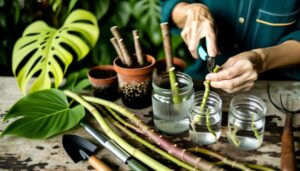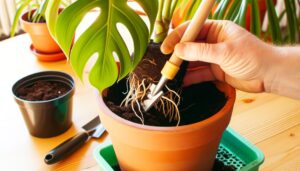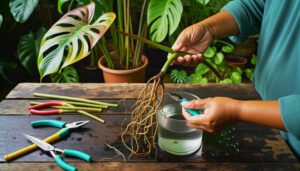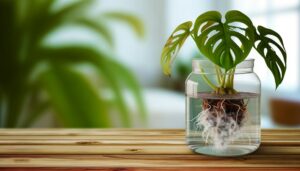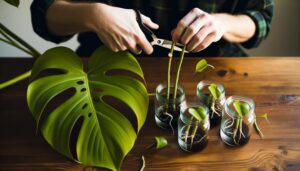How to Propagate Monstera in Leca? Step-by-Step Guide!
To propagate Monstera in leca, start by gathering leca balls, a transparent container, and distilled water. Choose a sturdy stem with a node and healthy leaves.
Cut 4-6 inches below the node, then trim excess leaves. Rinse and soak the leca balls for cleanliness.
Place the Monstera cutting with the node in direct contact with moist leca. Ensure humidity levels stay between 60-80%, and regularly check root color and firmness.
Once roots are developed, shift the Monstera to a well-draining soil mix. Maintain consistent hydration to promote healthy growth.
Follow these steps closely for successful propagation and more detailed care tips.

Key Takeaways
- Choose a healthy Monstera stem cutting with a node and trim it for optimal root development.
- Rinse and soak leca balls, then place the cutting with nodes directly in contact with moist leca.
- Maintain humidity levels between 60-80% and provide indirect light for the cutting.
- Regularly monitor root color, firmness, growth, and hydration levels for healthy development.
- Transition the rooted cutting to a well-draining potting mix and water thoroughly.
Gather Your Supplies
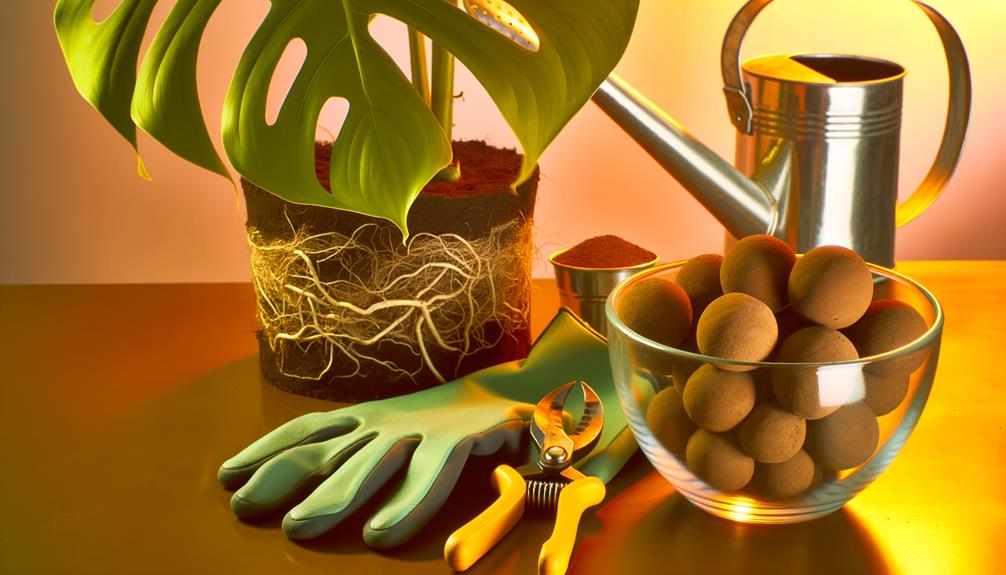
To propagate your Monstera in leca, you’ll need to gather several necessary supplies including leca balls, a transparent container, water, and sanitized cutting tools. Start by selecting high-quality leca balls, which provide excellent aeration and water retention.
Make sure your transparent container is appropriately sized and allows light penetration to monitor root growth.
Use distilled or filtered water to avoid mineral buildup that can harm roots. Sanitized cutting tools, such as sharp scissors or pruning shears, are essential to prevent introducing pathogens to your Monstera. You can sterilize tools using rubbing alcohol or boiling water.
Having these supplies ready guarantees a smooth propagation process, reducing the risk of complications and increasing the likelihood of successful root development.
Take a Healthy Cutting
Begin by choosing a sturdy Monstera stem with at least one node and a few healthy leaves, making sure it’s free of pests and disease. Use sterilized pruning shears to make a clean cut below the node. The node is essential because it contains the necessary cells for root development. Make sure the cutting is at least 4-6 inches long.
After cutting, you might notice a milky sap; this is normal. Place the cutting in water immediately to prevent air embolism. Allow it to sit in water for a few minutes as you prepare the next steps.
Keep the cutting in a bright, indirect light to promote photosynthesis without causing stress. This initial step is necessary for successful propagation.
Prepare the LECA
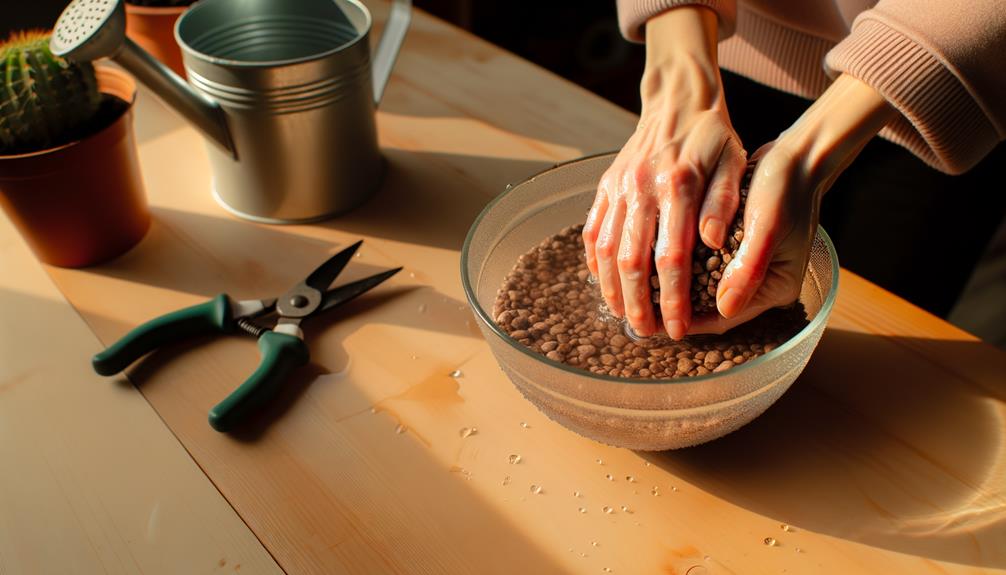
Begin by thoroughly rinsing the LECA (Lightweight Expanded Clay Aggregate) to remove any dust and debris that could impact the plant’s health. Place the LECA in a fine-mesh sieve and run water over it until the water runs clear. This step is essential to prevent any contaminants from hindering root development or introducing pathogens.
Next, soak the cleaned LECA in water for 24 hours. This guarantees the clay pellets are fully hydrated, which will help maintain a stable moisture level around the Monstera cutting. After soaking, drain the LECA thoroughly.
Clean the Cutting
To confirm your Monstera cutting is ready for propagation, start by trimming any excess leaves, leaving just one or two for photosynthesis.
Rinse the stem thoroughly under running water to remove any debris or pathogens.
Trim Excess Leaves
Carefully remove any excess leaves from the Monstera cutting, making sure that only a few healthy leaves remain to optimize energy distribution and root development. Use sterilized pruning shears or a sharp knife to make clean cuts, reducing the risk of disease transmission.
Focus on retaining leaves that are mature and undamaged, as these will be more efficient at photosynthesis. By minimizing the number of leaves, you’re allowing the cutting to direct more energy toward developing a robust root system.
Avoid leaving any torn or jagged edges on the stem, as these can become entry points for pathogens. Taking this thorough approach ensures that the cutting is primed for successful propagation in Leca.
Rinse Stem Thoroughly
After trimming the extra leaves, rinse the Monstera cutting’s stem thoroughly under lukewarm water to remove any sap, debris, or potential contaminants. This step is vital to prevent infections and guarantee a healthy propagation process.
Hold the cutting under running water for at least 30 seconds, rotating it to make sure all sides are cleansed. Use your fingers to gently rub off any visible dirt or residue. Avoid using soap or detergents, as these can harm the plant tissue. If the cutting has any aerial roots, rinse these as well.
Once rinsed, place the cutting on a clean paper towel to air dry for a few minutes before proceeding to the next steps. This guarantees all excess moisture is removed.
Disinfect Cutting Tool
Before making any cuts, make certain you disinfect your cutting tool with rubbing alcohol or a 10% bleach solution to eliminate any pathogens that could harm the Monstera cutting. This step is essential to prevent the introduction of bacteria or fungi that could compromise the health of your plant.
Immerse the blade in the solution for a minimum of 30 seconds, then let it air dry.
- Rubbing Alcohol: Use 70% isopropyl alcohol for effective disinfection.
- 10% Bleach Solution: Mix 1 part bleach with 9 parts water.
- Contact Time: Ensure the tool remains in the solution for at least 30 seconds.
- Air Dry: Allow the tool to dry completely before use.
- Repeat After Each Cut: Disinfect after every cut to maintain sterility.
Place Cutting in LECA
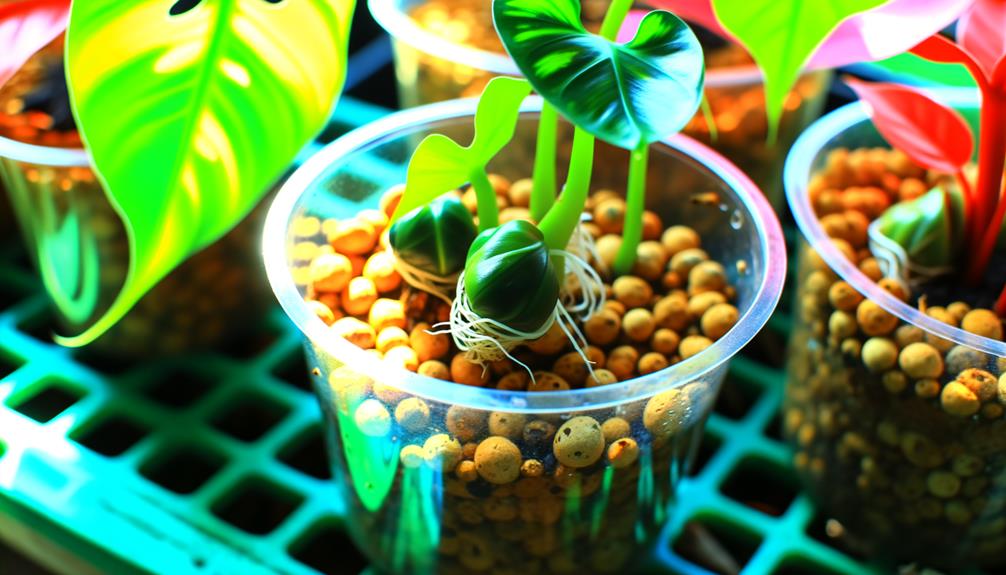
Begin by rinsing the LECA thoroughly to remove dust and debris, ensuring best water absorption.
Next, insert the Monstera cutting, making sure the nodes are in direct contact with the LECA for efficient root development.
Prepare the LECA
Guarantee the LECA is thoroughly rinsed to remove any dust or debris, enhancing its ability to provide a stable environment for the Monstera cutting.
Submerge the LECA in water, agitating it to dislodge particles. Drain and repeat until the water runs clear.
Sterilize the LECA by boiling it for 10 minutes to eliminate pathogens. Allow it to cool and dry completely before use.
- Rinsing: Cleanses LECA of dust and debris.
- Boiling: Sterilizes LECA, removing pathogens.
- Cooling: Ensures no thermal shock to the plant.
- Drying: Prevents excessive moisture retention.
- Agitation: Enhances the cleaning process.
Insert Monstera Cutting
Once the LECA is prepared, carefully position the Monstera cutting’s stem into the LECA, making sure the node is submerged but the leaves remain above the surface. Gently press the LECA around the stem to secure the cutting in place.
Make certain the node, which contains the growth point, is in contact with the moist LECA to stimulate root development. Use a container with drainage holes to allow excess water to escape, preventing root rot.
Periodically check the cutting to verify it remains securely positioned and the node stays moist. Proper placement is essential for successful propagation, as it encourages root growth and prevents the cutting from drying out or becoming waterlogged.
Your meticulous attention will promote a healthy Monstera propagation.
Monitor Moisture Levels
Regularly monitor the moisture levels in the LECA to guarantee the Monstera cutting receives sufficient hydration without becoming waterlogged. Check moisture by inserting a moisture meter into the LECA or by feeling the top layer.
Confirm the water level is just below the base of the cutting, allowing the roots to access moisture through capillary action. Refill as necessary to maintain consistent moisture without submerging the roots.
- Moisture Meter: Use for accurate readings.
- Top Layer: Feel with fingers; should be slightly moist.
- Water Reservoir: Keep water level just under the cutting base.
- Capillary Action: Helps roots draw moisture efficiently.
- Avoid Saturation: Prevents root rot and supports healthy growth.
Maintain Proper Humidity
Maintaining appropriate humidity levels is crucial for the successful propagation of Monstera in Leca, as it guarantees ideal growth conditions and prevents desiccation. Aim for humidity levels between 60-80%. Use a hygrometer to monitor the environment accurately. If needed, deploy a humidifier or place a tray with water near the plant to increase humidity. Promote good air circulation to prevent mold growth.
Here’s a quick reference table to help you:
| Humidity Level | Method to Achieve | Notes |
|---|---|---|
| 60-70% | Humidifier | Ideal for moderate growth |
| 70-80% | Water Tray | Boosts propagation rate |
| >80% | Reduce | Prevents mold issues |
| <60% | Increase | Prevents desiccation |
| 60-80% | Consistently | Optimal range |
Maintaining these levels ensures your Monstera thrives.
Monitor Root Growth
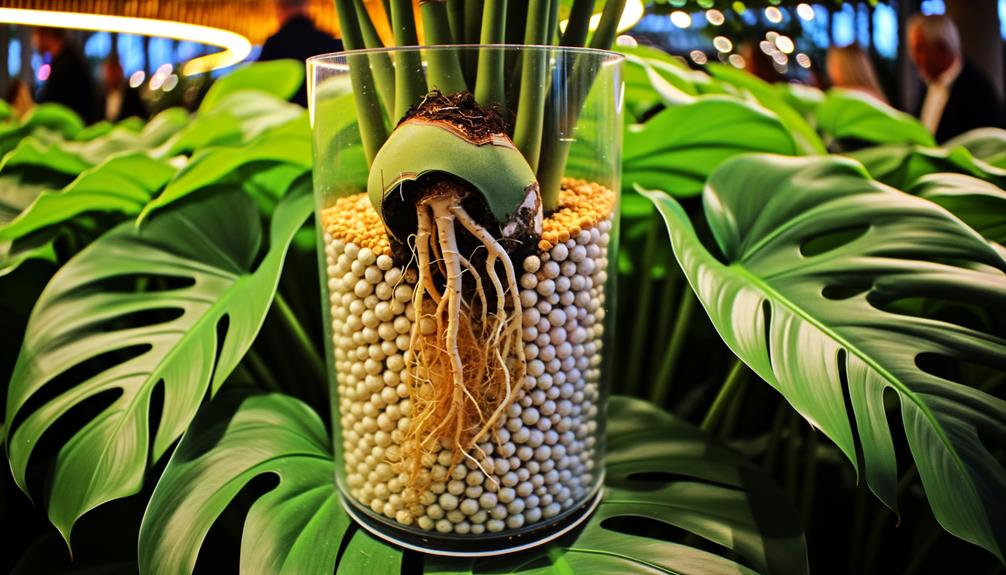
To observe root growth effectively, regularly inspect the Leca medium for new root development and any signs of decay. Examine the roots at least once a week for best results. Look for healthy, white roots and avoid any that appear brown or mushy, as these can indicate rot.
- Examine Root Color: Healthy roots should be white or pale tan.
- Check for Firmness: Roots should feel solid to the touch, not soft or slimy.
- Observe Growth Patterns: New roots should emerge from the nodes and extend into the Leca.
- Monitor Hydration Levels: Ensure the Leca remains moist but not saturated.
- Inspect for Pests: Look for any signs of pests that could impede root growth.
Regular monitoring will support strong development.
Transition to Soil
When changing your Monstera from Leca to soil, select a well-draining potting mix to prevent waterlogged roots. Begin by gently removing the plant from its Leca environment, taking care not to damage the delicate root system.
Rinse the roots to eliminate residual Leca particles. Fill a pot one-third full with your chosen soil mix, ensuring it contains components like perlite or bark to enhance aeration. Position the Monstera in the pot, carefully spreading out the roots.
Gradually add soil around the roots, firming it gently to eliminate air pockets. Water the plant thoroughly, allowing excess water to drain. Place the Monstera in indirect light and monitor moisture levels, watering only when the top inch of soil feels dry.
Conclusion
You’ve successfully propagated your Monstera in LECA! Like a scientist nurturing an experiment, you’ve meticulously followed each step.
Remember, maintaining humidity and monitoring root growth are vital for success. Shifting to soil is your final task, so be patient and attentive.
With careful observation, your Monstera will thrive, rewarding your effort with robust, healthy growth. Keep refining your technique, and soon, you’ll propagate plants with the precision of a seasoned botanist.
Happy growing!

